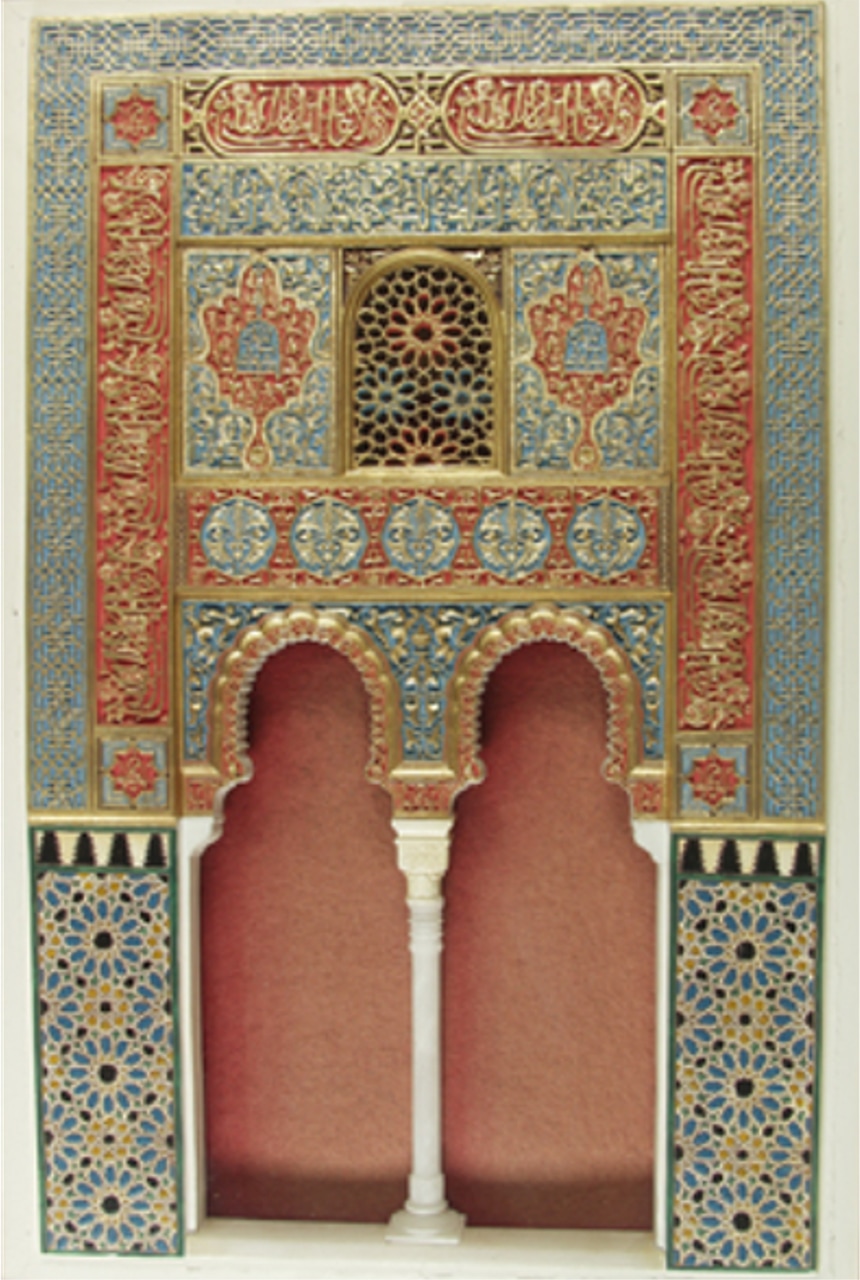
Architectural model of a façade of the Alhambra Palace, Granada
This nineteenth-century model is inspired by the Alhambra Palace, which was built by the Nasrid dynasty (1240–1492) in Granada during the last period of Islamic rule in the Iberian Peninsula (711–1492). The model is representative of the reproductions that were produced in workshops in Granada from the second half of the nineteenth century onwards and often sold to foreign travellers as expensive souvenirs. Made from plaster, alabaster, or wood, they are idealized reproductions at scale, which typically depict a doorway or a balcony surmounted by one or several windows. They feature polychrome tiles in the lower part and intricate stucco in the upper part of the wall. Rafael Contreras, the head restorer of the Alhambra (1847–89), was the first to set up a lucrative business in manufacturing such models, which fetched high prices at the time. Later practitioners, who were active well into the early twentieth century, include Enrique Linares and Rafael Rus Acosta.
The approximate date of this model can be established with the help of the label stuck on the back. It refers to the picture framer Alfred Lovell Price (1847–1928), who is known to have had a business on 37, Lower Church Street, Lancaster, between 1882 and 1896. Hence, he must have framed the model during this time for a British collector whose identity is unknown. It later belonged to the English composer Humphrey Procter-Gregg (1895–1980).
The commercial success of such reproductions was based on the rediscovery of the Alhambra Palace after it had suffered centuries of neglect. Renewed interest began in the late eighteenth century, but it was especially with the advent of the Romantic movement that European writers, architects, and artists—motivated by a yearning for the exotic—travelled to Granada and other Andalusian cities, such as Seville and Cordoba, where Spain’s Islamic past was clearly imprinted in its monuments. Nineteenth-century travelogues, paintings, prints, and even partial reconstructions of the Alhambra propelled the monument to international fame. Washington Irving’s The Alhambra. Tales and Sketches of the Moors and Spaniards (1832), an instant bestseller, gave stimulus to idealized visions of medieval Granada, marked by religious tolerance and an exquisitely sophisticated culture under Nasrid rule. Irving set the foundations for tourism to Granada. In parallel, British architect and designer, Owen Jones (1809–74), who was in Granada between 1834 and 1837, promoted the Alhambra Palace as the best example of Islamic architecture and ornament. Jones’s enthusiasm was contagious and inspired a fashion for Alhambra-style textiles, wallpaper, ceramics, and even architecture in Britain and beyond.
For European travellers, Andalusia was the nearest and most accessible place to gain a flavour of Islamic architecture. This interest was often part of a wider fascination with Islamic culture in North Africa and the Middle East, which developed against the backdrop of political and economic interests in the region.
 Click to zoom and pan
Click to zoom and pan
...
Your feedback is very important to us. Would you like to tell us why?
We will never display your feedback on site - this information is used for research purposes.
Artwork Details
Title
Architectural model of a façade of the Alhambra Palace, Granada.
Artist
Unknown artist (late nineteenth century).
Date
c. 1890.
Medium and Support
Polychrome plaster mounted on felt. In wooden frame under glass.
Dimensions
46.6 cm (length) x 33.2 cm (width) x 4.3 cm (depth).
Marks and Inscriptions
Label stuck on the back of the frame: ‘A. L. PRICE, Practical Carver and Gilder, / and Picture Frame Manufacturer. / ENGRAVINGS AND DRAWINGS CAREFULLY MOUNTED AND FRAMED. / Every description of Picture Frames made to order on the shortest notice. / OLD WORK RE-GILT EQUAL TO NEW. / Oil Paintings Restored, Cleaned, and Varnished. / Mildew Spots taken out of Engravings and Carefully Cleaned. / 37, Lower Church Streeet, Lancaster.’.
Acquisition Details
Bequest from Prof. Humphrey Procter-Gregg.
Previous Owners
None.
Institution
The Oriental Museum, Durham University.
Bibliography
Claudia Heide Hopkins, ‘The Spanish Picturesque’ and ‘A Dream of the South’, in The Discovery of Spain: British Artists and Collectors, Goya to Picasso, ed. David Howarth (Edinburgh: National Galleries of Scotland, 2009), pp. 47–64 & 65–79;
Asun González Pérez, ‘Reconstructing the Alhambra: Rafael Contreras and Architectural Models of the Alhambra in the Nineteenth Century’, Art in Translation, 9.1 (2017): 29–49.
